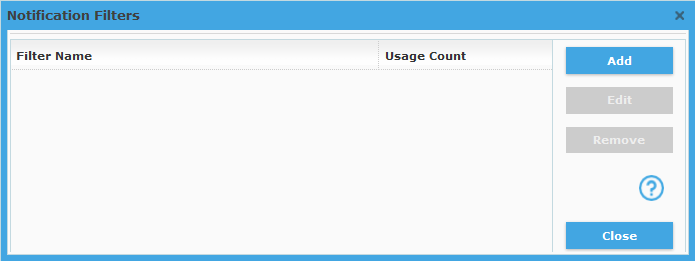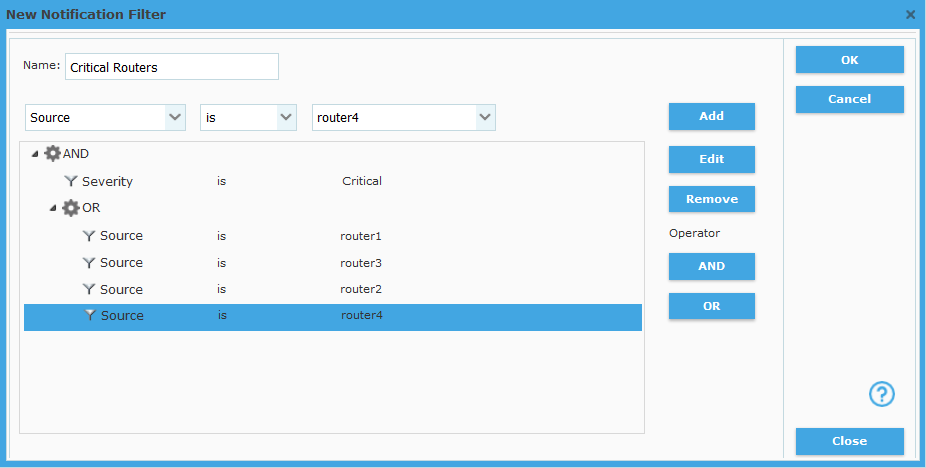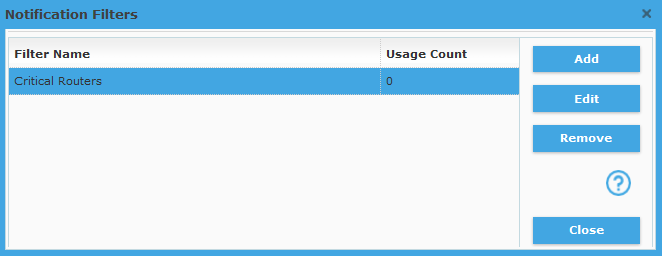Notification filters enable execution of e-mail and command notification operations on specific events/alarms. Notification filters are assigned to Mail and CMD notifications, as described in the Configuring Notifications topic.
Note: Every notification operation (Mail or CMD) must have a notification filter assigned. Only those events/alarms that match the notification filter criteria, will execute the associated notification operation (e-mail sending or command spawning).
Notification filters are created in the New Notification Filter dialog box (Figure), which contains a toolbar that lets you create filter conditions and add them to the filter one-by-one.
![]()
CONDITION TYPE |
OPERATOR |
VALUE |
The new condition toolbar lets you create a filter condition by selecting the condition type, operator and value from the corresponding drop-down lists. Once the condition is configured, you can add it to the filter by clicking the Add button in the right section of the New/Edit Alarm Filter dialog box. The central section of the dialog box (Conditions panel) displays the entire filter consisting of filter conditions and relations between them. The Conditions panel displays a filter in form of a hierarchical tree, where the filter conditions are connected with logical operators (AND, OR).
This topic describes how to configure and manage notification filters in Net Inspector. The principle is the same as the one of configuring alarm filters.
Note: Only users with administrator access rights are permitted to configure settings described in this topic.
To open the Notification Filters dialog box
Select the Settings / Notification Filters command to open the Notification Filters dialog box (as shown in the image below).
Figure: Notification Filters dialog box

The Notification Filters dialog box is used for managing notification filters, as follows:
To create a new notification filter, click the Add button in the Notification Filters dialog box. This opens the New Notification Filter dialog box (as shown in the figure below).
To edit an existing filter, select it in the Notification Filters dialog box and click the Edit button. This opens the Edit Notification Filter dialog box, which has the same appearance as the New Notification Filter dialog box.
To delete an existing filter, select it in the Notification Filters dialog box and click the Remove button. Filters that are in use (assigned to one or more notification operations) cannot be deleted.
To create or edit a notification filter
In the Notification Filters dialog box, click the Add or Edit button, to open the New/Edit Notification Filter dialog box (shown below).
Figure: New/Edit Notification Filter dialog box

Into the Name input line, specify the filter name. This is a label under which all the settings in this dialog box are saved.
In the New Condition toolbar, select the desired values from the Condition type, Operator, and Value drop-down lists to create a filter condition. You can select among the following types of conditions:
Severity
Specifies the severity level of the alarm. If this condition type is selected, you can choose the alarm severity level from the Value drop-down list (e.g. “Critical”, “Major”, etc.).
Source
Uniquely identifies the device, which has triggered the alarm. If this type of condition is selected, select the source device from the Value drop-down list.
Source name
Specifies the name of the device (as displayed on the workspace), which has triggered the alarm. If this condition type is selected, you can enter the name of the device into the Value input line. Note, however, that two or more objects can have the same name. Use the Source condition type to uniquely specify the source in such case.
Source info
Specifies additional information about the problem (as displayed in the Source Info column in the Active Alarms frame). If this condition type is selected, you can enter additional informational about the object into the Value input line (e.g., “Processor:#1”).
Source type
Specifies the type of the device, which has triggered the alarm. If this condition type is selected, you can choose the device type from the Value drop-down list (e.g. “IP”).
Message
A short description of the alarm. If this condition type and the operator “is” or “is not” is selected, you can choose a message from the list of all messages in the Value drop-down list (e.g. “Device is down”). If this condition type and the operator “contains” is selected, you can enter a text string (e.g., “Dev”) into the Value input line to find all alarms whose message field contains the specified character(s).
Cause
Specifies the cause of the alarm. If this condition type is selected, you can choose a cause from the Value drop-down list (e.g. “Lan Error”).
Event Type
Specifies the type of the event/alarm. If this condition type is selected, you can choose an alarm type from the Value drop-down list (e.g. “Communication”).
Event state
Specifies the state of the alarm. If this condition type is selected, you can choose an event or alarm state from the Value drop-down list (e.g. “ACKNOWLEDGED” or “MANUAL CLEARED” or “AUTO CLEARED”, etc.).
(Un)Acknowledge time
Specifies the date and time of acknowledging or unacknowledging the alarm. If this condition type is selected, you can enter the desired date and time into the Value input line, using the built-in Calendar.
(Un)Clear time
Specifies the date and time of clearing or unclearing the alarm. If this condition type is selected, you can enter the desired date and time into the Value input line, using the built-in Calendar.
Event state info
Specifies who has changed the state of the alarm as last. This can be either a user that has managed the alarm (e.g., acknowledged, unacknowledged, manually cleared) or the “Auto” if the alarm has been automatically cleared by the system. When specifying a user, you can also specify the location (IP address) of the user who has managed the alarm in square brackets (e.g., operator [192.168.10.120]). If this condition type is selected, you can enter an event state info into the Value input line (e.g. “admin [192.168.10.123]” or “Auto”, etc.).
After you have selected the desired entries from the Condition type, Operator, and Value drop-down lists, click the Add button to add the condition to the Filter. The added condition will appear in the central section of the dialog box (Conditions panel).
Repeat steps 3-4 above to add additional conditions to the filter.
To add a logical AND or OR operator to the filter, select the target position for the new operation in the Conditions panel and click the AND or OR button in the right-hand side of the New/Edit Notification Filter dialog box.
Note: If you add two or more conditions of the same type (e.g., Severity=Critical and Severity=Major), these conditions should be combined with the logical OR operator, whereas conditions of different types (e.g., Severity=Critical and Message=Device is down) can be combined with the logical AND or the logical OR operator.
To remove a condition from the filter, select it and click the Remove button.
When you have added all filter conditions to the filter, click the OK button in the upper-right section of the dialog box to create the filter and close the New/Edit Notification Filter dialog box. This filter will be available for selection in the Filter drop-down list in the New/Edit Mail Notification dialog box and the New/Edit CMD Notification dialog box.
The newly configured filter appears in the Notification Filters dialog box (as shown in the image below). Click the Close button in the lower-right section of the dialog box to close it.
Figure: A new filter in the Notification Filters dialog box

Tip: After you have created a notification filter, you can assign it to a Mail or CMD notification operation, as described in the Configuring Notifications topic.